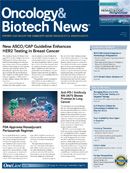Publication
Article
Oncology & Biotech News
Colonoscopy Screening at 10-Year Intervals May Prevent 40% of Colorectal Cancers
Author(s):
Forty percent of cases of colorectal cancer may be prevented if patients at average risk for the disease undergo a screening colonoscopy every 10 years
Forty percent of cases of colorectal cancer may be prevented if patients at average risk for the disease undergo a screening colonoscopy every 10 years, according to a prospective analysis published in The New England Journal of Medicine.
Reiko Nishihara, PhD, and colleagues at the Harvard School of Public Health analyzed the association between lower gastrointestinal endoscopy and the long-term risk of incident colorectal cancer in two large US prospective cohorts.
“Our findings support the 10-year examination interval recommended by existing guidelines for persons at average risk who have a negative colonoscopy,” the authors reported.
The investigators used data from the Nurses’ Health Study and the Health Professionals Follow-up Study. The former study included 121,700 female nurses who were 30 to 55 years of age at the time of enrollment in 1976, while the latter study included 51,529 male healthcare professionals who were 40 to 75 years of age at enrollment in 1986. The current analysis involved 88,902 participants (31,736 men and 57,166 women) from the two long-term studies.
Subjects completed questionnaires every 2 years over a period of 22 years. Specifically, they were asked if they had undergone either sigmoidoscopy or colonoscopy and, if so, the reason for the test. The researchers later decided to also collect detailed information on whether an individual’s prior lower endoscopies were colonoscopies or sigmoidoscopies.
During the study period, there were 1815 cases of colorectal cancer and 474 deaths from the disease.
The multivariate hazard ratios (HRs) for colorectal cancer among individuals who had undergone endoscopy compared with those who had not undergone endoscopy were 0.57 (95% CI, 0.45-0.72) after removal of adenomatous polyps, 0.60 (95% CI, 0.53-0.68) after negative sigmoidoscopy, and 0.44 (95% CI, 0.38-0.52) after negative colonoscopy.
Negative colonoscopy was associated with a significantly decreased risk of proximal colon cancer (multivariate HR = 0.73; 95% CI, 0.57-0.92).
Nishihara et al also documented lower mortality from colorectal cancer in participants who had undergone screening sigmoidoscopy (multivariate HR = 0.59; 95% CI, 0.45-0.76) and in individuals who had undergone screening colonoscopy (multivariate HR = 0.32; 95% CI, 0.24-0.45).
Reduced mortality from proximal colon cancer was seen after screening colonoscopy (multivariate HR, 0.47; 95% CI, 0.29-0.76) but not after sigmoidoscopy.
The analysis also showed that, as with earlier reports, cancers diagnosed within 5 years after colonoscopy were more likely than those diagnosed more than 5 years after colonoscopy to have the CpG island methylator phenotype and microsatellite instability.
The authors say that their findings are in line with the results of the National Polyp Study, which reported a decreased incidence of colorectal cancer among individuals after colonoscopic polypectomy versus population-based estimates of expected rates of colorectal cancer after colonoscopic polypectomy.
They also noted that because they gathered information every 2 years over a period of 22 years, they were able to update endoscopy status to accurately determine associations with the subsequent risk of colorectal cancer or death.
In addition, detailed information about exposures such as lifestyle factors allowed them to “finely adjust” for possible confounders.
The study’s prospective design is also an important study strength because it minimized biases that occur with case-control studies, including recall and selection biases, they said.
Finally, they cite the potential for unmeasured confounding as a study limitation, including bias due to the use of pooled data from two separate cohorts. In addition, because all subjects were healthcare professionals, the results might not be generalizable to other populations, according to the authors.
Nishihara R, Wu K, Lochhead P, et al. Long-term colorectal-cancer incidence and mortality after lower endoscopy. N Engl J Med. 2013;369(12):1095-1105.

































%20(2)%201-Recovered-Recovered-Recovered-Recovered-Recovered-Recovered-Recovered-Recovered-Recovered-Recovered-Recovered-Recovered-Recovered-Recovered-Recovered-Recovered-Recovered.jpg?fit=crop&auto=format)
%20(2)%201-Recovered-Recovered-Recovered-Recovered-Recovered-Recovered-Recovered-Recovered-Recovered-Recovered-Recovered-Recovered-Recovered-Recovered-Recovered-Recovered-Recovered.jpg?fit=crop&auto=format)
